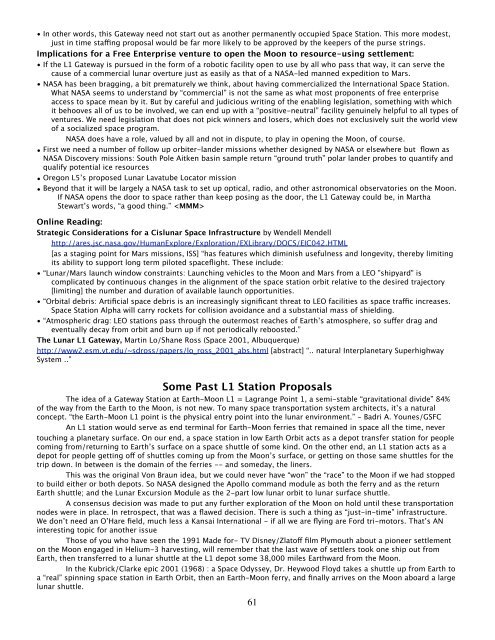Space Transportation - mmmt_transportation.pdf - Moon Society
Space Transportation - mmmt_transportation.pdf - Moon Society
Space Transportation - mmmt_transportation.pdf - Moon Society
Create successful ePaper yourself
Turn your PDF publications into a flip-book with our unique Google optimized e-Paper software.
• In other words, this Gateway need not start out as another permanently occupied <strong>Space</strong> Station. This more modest,<br />
just in time staffing proposal would be far more likely to be approved by the keepers of the purse strings.<br />
Implications for a Free Enterprise venture to open the <strong>Moon</strong> to resource-using settlement:<br />
• If the L1 Gateway is pursued in the form of a robotic facility open to use by all who pass that way, it can serve the<br />
cause of a commercial lunar overture just as easily as that of a NASA-led manned expedition to Mars.<br />
• NASA has been bragging, a bit prematurely we think, about having commercialized the International <strong>Space</strong> Station.<br />
What NASA seems to understand by “commercial” is not the same as what most proponents of free enterprise<br />
access to space mean by it. But by careful and judicious writing of the enabling legislation, something with which<br />
it behooves all of us to be involved, we can end up with a “positive-neutral” facility genuinely helpful to all types of<br />
ventures. We need legislation that does not pick winners and losers, which does not exclusively suit the world view<br />
of a socialized space program.<br />
NASA does have a role, valued by all and not in dispute, to play in opening the <strong>Moon</strong>, of course.<br />
• First we need a number of follow up orbiter-lander missions whether designed by NASA or elsewhere but flown as<br />
NASA Discovery missions: South Pole Aitken basin sample return “ground truth” polar lander probes to quantify and<br />
qualify potential ice resources<br />
• Oregon L5’s proposed Lunar Lavatube Locator mission<br />
• Beyond that it will be largely a NASA task to set up optical, radio, and other astronomical observatories on the <strong>Moon</strong>.<br />
If NASA opens the door to space rather than keep posing as the door, the L1 Gateway could be, in Martha<br />
Stewart’s words, “a good thing.” <br />
Online Reading:<br />
Strategic Considerations for a Cislunar <strong>Space</strong> Infrastructure by Wendell Mendell<br />
http://ares.jsc.nasa.gov/HumanExplore/Exploration/EXLibrary/DOCS/EIC042.HTML<br />
[as a staging point for Mars missions, ISS] “has features which diminish usefulness and longevity, thereby limiting<br />
its ability to support long term piloted spaceflight. These include:<br />
• “Lunar/Mars launch window constraints: Launching vehicles to the <strong>Moon</strong> and Mars from a LEO "shipyard" is<br />
complicated by continuous changes in the alignment of the space station orbit relative to the desired trajectory<br />
[limiting] the number and duration of available launch opportunities.<br />
• “Orbital debris: Artificial space debris is an increasingly significant threat to LEO facilities as space traffic increases.<br />
<strong>Space</strong> Station Alpha will carry rockets for collision avoidance and a substantial mass of shielding.<br />
• “Atmospheric drag: LEO stations pass through the outermost reaches of Earth’s atmosphere, so suffer drag and<br />
eventually decay from orbit and burn up if not periodically reboosted.”<br />
The Lunar L1 Gateway, Martin Lo/Shane Ross (<strong>Space</strong> 2001, Albuquerque)<br />
http://www2.esm.vt.edu/~sdross/papers/lo_ross_2001_abs.html [abstract] “.. natural Interplanetary Superhighway<br />
System ..”<br />
Some Past L1 Station Proposals<br />
The idea of a Gateway Station at Earth-<strong>Moon</strong> L1 = Lagrange Point 1, a semi-stable “gravitational divide” 84%<br />
of the way from the Earth to the <strong>Moon</strong>, is not new. To many space <strong>transportation</strong> system architects, it’s a natural<br />
concept. “the Earth-<strong>Moon</strong> L1 point is the physical entry point into the lunar environment.” - Badri A. Younes/GSFC<br />
An L1 station would serve as end terminal for Earth-<strong>Moon</strong> ferries that remained in space all the time, never<br />
touching a planetary surface. On our end, a space station in low Earth Orbit acts as a depot transfer station for people<br />
coming from/returning to Earth’s surface on a space shuttle of some kind. On the other end, an L1 station acts as a<br />
depot for people getting off of shuttles coming up from the <strong>Moon</strong>’s surface, or getting on those same shuttles for the<br />
trip down. In between is the domain of the ferries -- and someday, the liners.<br />
This was the original Von Braun idea, but we could never have “won” the “race” to the <strong>Moon</strong> if we had stopped<br />
to build either or both depots. So NASA designed the Apollo command module as both the ferry and as the return<br />
Earth shuttle; and the Lunar Excursion Module as the 2-part low lunar orbit to lunar surface shuttle.<br />
A consensus decision was made to put any further exploration of the <strong>Moon</strong> on hold until these <strong>transportation</strong><br />
nodes were in place. In retrospect, that was a flawed decision. There is such a thing as “just-in-time” infrastructure.<br />
We don’t need an O’Hare field, much less a Kansai International - if all we are flying are Ford tri-motors. That’s AN<br />
interesting topic for another issue<br />
Those of you who have seen the 1991 Made for- TV Disney/Zlatoff film Plymouth about a pioneer settlement<br />
on the <strong>Moon</strong> engaged in Helium-3 harvesting, will remember that the last wave of settlers took one ship out from<br />
Earth, then transferred to a lunar shuttle at the L1 depot some 38,000 miles Earthward from the <strong>Moon</strong>.<br />
In the Kubrick/Clarke epic 2001 (1968) : a <strong>Space</strong> Odyssey, Dr. Heywood Floyd takes a shuttle up from Earth to<br />
a “real” spinning space station in Earth Orbit, then an Earth-<strong>Moon</strong> ferry, and finally arrives on the <strong>Moon</strong> aboard a large<br />
lunar shuttle.<br />
61















